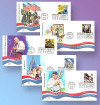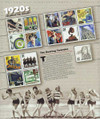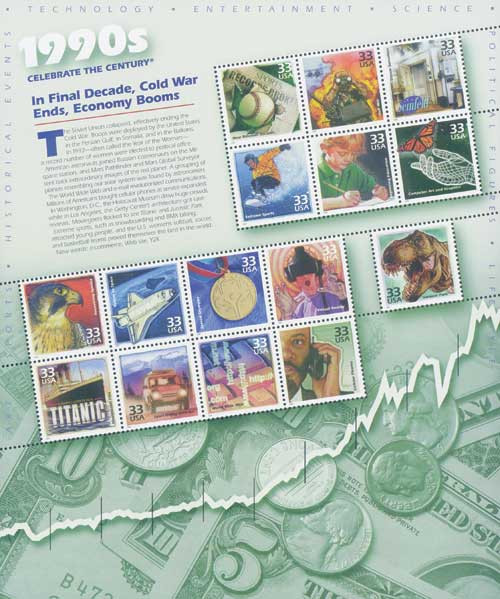
# 3184 - 1998 32c Celebrate the Century: 1920s
US #3184
1998 Celebrate the Century (1920s)
• The third sheet in the Celebrate the Century stamp series issued from 1998-2000
• Includes 15 stamps picturing important events from the 1920s
• Each stamp has text on the back detailing the event shown in the front design
Stamp Category: Commemorative
Set: Celebrate the Century
Value: 32¢ First Class Mail Rate
First Day of Issue: May 28, 1998
First Day City: Chicago, Illinois
Quantity Issued: 188,000,000
Printed by: Ashton Potter (USA) Ltd.
Printing Method: Offset, Intaglio
Format: Panes of 15
Perforations: 11.6
Tagging: Block Tagging
Why the stamps were issued: To commemorate important historical and cultural events from the 1920s that have a lasting legacy in the United States.
About the stamp designs: Pictures artwork by illustrators David Meltzer of Huntington Valley, Pennsylvania, and Keith Birdsong of Muskogee, Oklahoma. The following topics were chosen for the 15 stamps on this sheet (and corresponding back markings of each):
Babe Ruth – Babe Ruth hit 54 home runs in 1920. He went on to hit 59 homers in 1921, and 60 in 1927. Twice he hit 3 home runs in a single game of a World Series. One of his nicknames was the Sultan of Swat.
The Gatsby Style – F. Scott Fitzgerald exposed the lavish and insensitive lifestyle of the rich and glamorous in the classic 1925 novel, The Great Gatsby.
Prohibition Enforced – The 18th Amendment prohibited the manufacture and sale of alcoholic beverages. The detail from the Ben Shahn painting, from the Museum of the City of New York, shows federal agents disposing of wine.
Electric Toy Trains – Children played with colorful and elaborate electric toy trains, complete with stations, houses, accessories, track and transformers. The most popular sets were produced by Lionel.
19th Amendment – The 19th Amendment to the US Constitution was ratified August 26, 1920. The fight for woman’s suffrage had been won, ending a struggle that began in the mid-nineteenth century.
Emily Post’s Etiquette – In an era of social mobility, Emily Post defined modern good manners and conduct. Her books, radio programs, and syndicated newspaper column set the standard for etiquette throughout the twentieth century.
Margaret Mead, Anthropologist – Anthropologist Margaret Mead explored the effect of culture on the behavior and personalities of children and adults, as well as the differences between men and women.
Flappers Do The Charleston – Caricaturist John Held Jr. portrayed the fun-loving, escapist lifestyle of the Roaring Twenties. His drawings of young women called flappers symbolized the decade.
Radio Entertains America – By the end of the 1920s, radio had become a national obsession. Families crowded around their sets to listen to newscasts, comedy and children’s shows, variety hours, and presidential speeches.
Art Deco – The Art Deco style in architecture and the decorative arts combines sleek elegance, geometric shapes, and varied materials. One of the finest examples of the style, the Chrysler Building in New York reflects America’s exuberance in the 1920s.
Jazz Flourishes – Created in the United States, jazz was spread by radio and recordings in the 1920s. Among the leading performers were Louis Armstrong, Jelly Roll Morton, Joe “King” Oliver, Fletcher Henderson, and Bix Beiderbecke.
Four Horsemen of Notre Dame – In the 1920s, college football’s most famous backfield was Notre Dame’s four Horsemen: Don Miller, Elmer Layden, Jim Crowley, and Harry Stuhldreher. None of them weighed more than 170 pounds.
Lindbergh Flies Atlantic – On May 20-21, 1927, Charles Lindbergh completed the first nonstop solo trans-Atlantic flight. He left from Long Island and flew 3,600 miles to Paris in 33 ½ hours.
American Realism – Painter Edward Hopper (1882-1967) is possibly the most important American realist of the period. The detail from the Automat, at the Des Moines Art Center, typifies his attention to the human feelings of alienation and introspection.
Stock Market Crash 1929 – Stock market price plummeted on Black Thursday, October 24, 1929, and collapsed on October 29. Banks and businesses closed and the Great Depression soon followed.
First Day City: The First Day of Issue Ceremony was held at Chicago’s Celebrate on State Street festival.
About the Celebrate the Century series: The USPS launched the Celebrate the Century series in 1998 to mark the end of the 20th century and herald the arrival of the 21st. The series includes 10 sheets of 15 stamps (150 in total), with each honoring important moments from a different decade (1900s, 10s, 20s, 30s, 40s, 50s, 60s, 70s, 80s, and 90s). At the time of completion, it was the longest and most ambitious commemorative stamp series in US history.
US #3184
1998 Celebrate the Century (1920s)
• The third sheet in the Celebrate the Century stamp series issued from 1998-2000
• Includes 15 stamps picturing important events from the 1920s
• Each stamp has text on the back detailing the event shown in the front design
Stamp Category: Commemorative
Set: Celebrate the Century
Value: 32¢ First Class Mail Rate
First Day of Issue: May 28, 1998
First Day City: Chicago, Illinois
Quantity Issued: 188,000,000
Printed by: Ashton Potter (USA) Ltd.
Printing Method: Offset, Intaglio
Format: Panes of 15
Perforations: 11.6
Tagging: Block Tagging
Why the stamps were issued: To commemorate important historical and cultural events from the 1920s that have a lasting legacy in the United States.
About the stamp designs: Pictures artwork by illustrators David Meltzer of Huntington Valley, Pennsylvania, and Keith Birdsong of Muskogee, Oklahoma. The following topics were chosen for the 15 stamps on this sheet (and corresponding back markings of each):
Babe Ruth – Babe Ruth hit 54 home runs in 1920. He went on to hit 59 homers in 1921, and 60 in 1927. Twice he hit 3 home runs in a single game of a World Series. One of his nicknames was the Sultan of Swat.
The Gatsby Style – F. Scott Fitzgerald exposed the lavish and insensitive lifestyle of the rich and glamorous in the classic 1925 novel, The Great Gatsby.
Prohibition Enforced – The 18th Amendment prohibited the manufacture and sale of alcoholic beverages. The detail from the Ben Shahn painting, from the Museum of the City of New York, shows federal agents disposing of wine.
Electric Toy Trains – Children played with colorful and elaborate electric toy trains, complete with stations, houses, accessories, track and transformers. The most popular sets were produced by Lionel.
19th Amendment – The 19th Amendment to the US Constitution was ratified August 26, 1920. The fight for woman’s suffrage had been won, ending a struggle that began in the mid-nineteenth century.
Emily Post’s Etiquette – In an era of social mobility, Emily Post defined modern good manners and conduct. Her books, radio programs, and syndicated newspaper column set the standard for etiquette throughout the twentieth century.
Margaret Mead, Anthropologist – Anthropologist Margaret Mead explored the effect of culture on the behavior and personalities of children and adults, as well as the differences between men and women.
Flappers Do The Charleston – Caricaturist John Held Jr. portrayed the fun-loving, escapist lifestyle of the Roaring Twenties. His drawings of young women called flappers symbolized the decade.
Radio Entertains America – By the end of the 1920s, radio had become a national obsession. Families crowded around their sets to listen to newscasts, comedy and children’s shows, variety hours, and presidential speeches.
Art Deco – The Art Deco style in architecture and the decorative arts combines sleek elegance, geometric shapes, and varied materials. One of the finest examples of the style, the Chrysler Building in New York reflects America’s exuberance in the 1920s.
Jazz Flourishes – Created in the United States, jazz was spread by radio and recordings in the 1920s. Among the leading performers were Louis Armstrong, Jelly Roll Morton, Joe “King” Oliver, Fletcher Henderson, and Bix Beiderbecke.
Four Horsemen of Notre Dame – In the 1920s, college football’s most famous backfield was Notre Dame’s four Horsemen: Don Miller, Elmer Layden, Jim Crowley, and Harry Stuhldreher. None of them weighed more than 170 pounds.
Lindbergh Flies Atlantic – On May 20-21, 1927, Charles Lindbergh completed the first nonstop solo trans-Atlantic flight. He left from Long Island and flew 3,600 miles to Paris in 33 ½ hours.
American Realism – Painter Edward Hopper (1882-1967) is possibly the most important American realist of the period. The detail from the Automat, at the Des Moines Art Center, typifies his attention to the human feelings of alienation and introspection.
Stock Market Crash 1929 – Stock market price plummeted on Black Thursday, October 24, 1929, and collapsed on October 29. Banks and businesses closed and the Great Depression soon followed.
First Day City: The First Day of Issue Ceremony was held at Chicago’s Celebrate on State Street festival.
About the Celebrate the Century series: The USPS launched the Celebrate the Century series in 1998 to mark the end of the 20th century and herald the arrival of the 21st. The series includes 10 sheets of 15 stamps (150 in total), with each honoring important moments from a different decade (1900s, 10s, 20s, 30s, 40s, 50s, 60s, 70s, 80s, and 90s). At the time of completion, it was the longest and most ambitious commemorative stamp series in US history.














